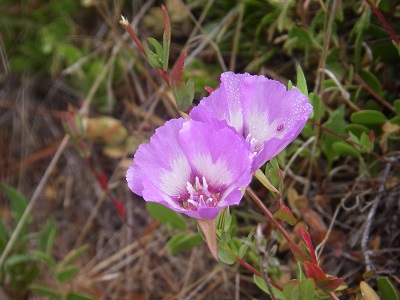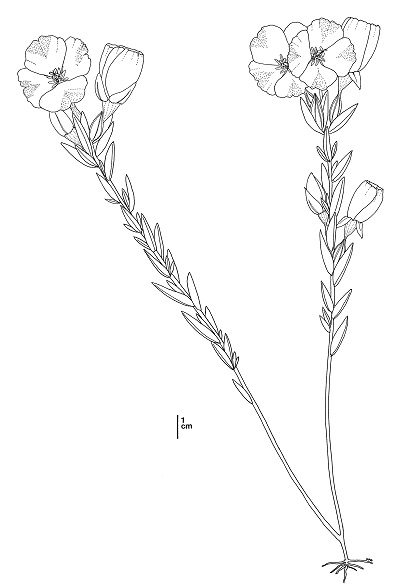(Clarkia imbricata)
 Clarkia imbricata. U.S. Fish and Wildlife photo by Elizabeth Warne.
Clarkia imbricata. U.S. Fish and Wildlife photo by Elizabeth Warne.
 Clarkia imbricata. CDFW illustration by Mary Ann Showers. (Click to enlarge)
Clarkia imbricata. CDFW illustration by Mary Ann Showers. (Click to enlarge)
Vine Hill clarkia is a California endangered plant species, which means that killing or possessing any part of the plant is prohibited by the California Endangered Species Act (CESA). This species is also listed as endangered under the federal Endangered Species Act (ESA). Vine Hill clarkia is an annual herb in the evening-primrose family (Onagraceae) that grows up to two feet tall. Vine Hill clarkia blooms from June through July and it has showy flowers with four fan-shaped lavender-pink petals that are paler toward the center with a distinguishing dark purple to red triangular spot extending from the middle to the upper edges of each petal. The flowers of plants in the evening-primrose family have an inferior ovary which means that the ovary is positioned below the sepals, petals, and stamens.
Vine Hill clarkia is endemic (limited) to the Vine Hill area in Sonoma County. Historically, this species is only known from three wild populations: (1) the Lewis-type locality; (2) the Sequoia Circle locality; and (3) the Pitkin Marsh locality. The Lewis-type locality was likely extirpated prior to 1974 and the Pitkin Marsh locality was extirpated between 1981 and 1984. The populations at these localities were never known to be common but were likely extirpated due agricultural and urban development. The Sequoia Circle locality occurs on privately owned land and has not been surveyed since 1997. Seeds were collected from the Sequoia Circle locality in 1974, and Vine Hill clarkia was introduced and established on the 1.5-acre Vine Hill preserve, which is owned and managed by the California Native Plant Society (CNPS). This population has anywhere from 500 to 9,000 plants annually and is the only population known to still exist. This species grows at elevations of around 250 feet on acidic, sandy loam soils in an area referred to as the Sonoma Barrens. The Sonoma Barrens is a unique area between the maritime and inland climates that is subject to wide temperature fluctuations. The soil is wet and slick in the winters and then dries to a firm crust in the spring and summer. It has been hypothesized that this particular soil type aids in providing a shady barrier for the roots of Vine Hill clarkia to establish by reducing evaporation and helping to retain moisture within the cracks of the soil. Vine Hill clarkia is associated with chaparral and valley grassland vegetation communities that include plant species such as chamise (Adenostoma fasciculatum), coyote brush (Baccharis pilularis), Vine Hill ceanothus (Ceanothus foliosus var. vineatus), salal (Gaultheria shallon), thin-lobed horkelia (Horkelia tenuiloba), California coffee berry (Frangula californica), bear grass (Xerophyllum tenax), and the CESA endangered Vine Hill manzanita (Arctostaphylos densiflora).
One of the primary threats to the Vine Hill clarkia is competition for light with native and nonnative species. Historically, this shade-intolerant plant may have been tolerant of the encroachment of larger native shrubs, because the shrubs would be frequently reduced by periodic fires that swept through the landscape. Fire suppression in the Vine Hill Preserve encourages encroachment of the chaparral plant community into the suitable grassland habitat where the Vine Hill clarkia grows. The shrubs shade Vine Hill clarkia and increase leaf litter, facilitating the establishment of nonnative species such as common velvet grass (Holcus lanatus). Due to Vine Hill clarkia’s small population size, it is also vulnerable to extinction from random events such as disease, herbivory, intense wildfires, floods, droughts, and competition from invasive species. Low genetic diversity is also a risk because the entire population at Vine Hill Preserve originated from a limited number of seeds collected from the Sequoia Circle locality. Low genetic variability may result in the species being unable to adapt to environmental pressures such as disease and climate change.
Recommended recovery efforts listed in the U.S. Fish and Wildlife 5-year Review of Clarkia imbricata (PDF) include the protection, maintenance, and continued monitoring of the existing population of Vine Hill clarkia and establishing new outplanting efforts in its native range and on protected lands to increase population numbers. Additional recommended recovery efforts include the removal of nonnative plants, controlling the encroachment of native shrubs, and collecting scientific data on the response of the Vine Hill clarkia seed bank to fire, the genetic diversity of the species, and its seed germination requirements (e.g. temperature, moisture, cold stratification).
CDFW may issue scientific and research permits for Vine Hill clarkia pursuant to CESA, and you can visit our website to learn more about the California laws protecting Vine Hill clarkia and other California native plants. Populations of Vine Hill clarkia occur in CDFW’s Bay Delta Region. More information is also available from U.S. Fish and Wildlife Service species profile for Clarkia imbricata.
Updated 8/14/2020